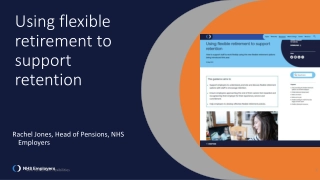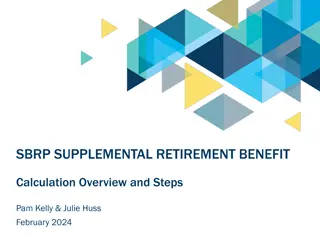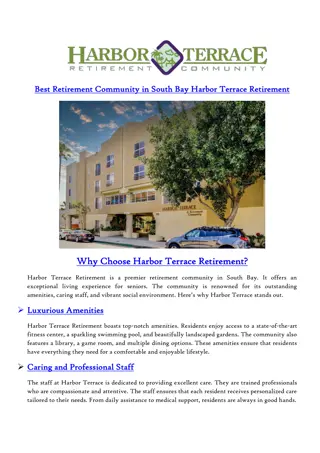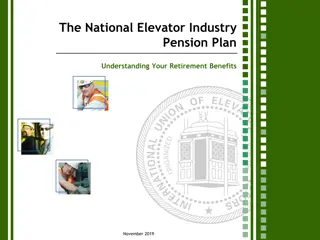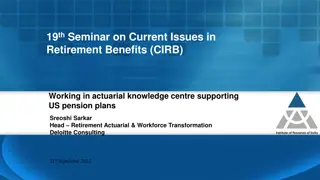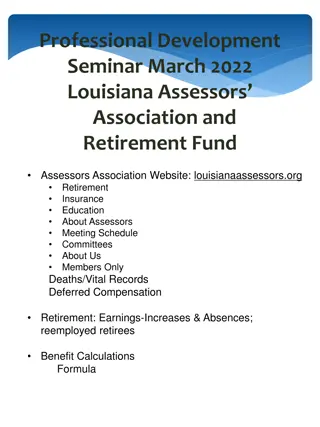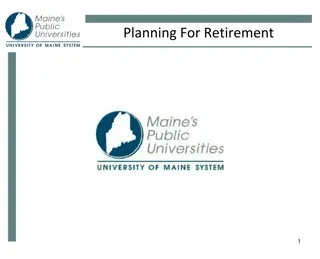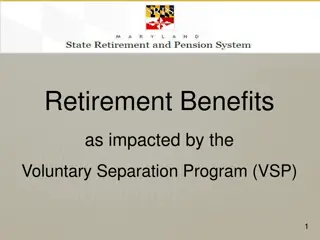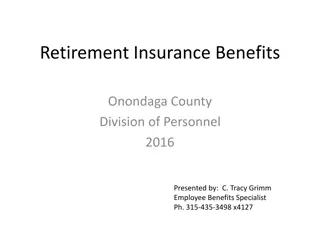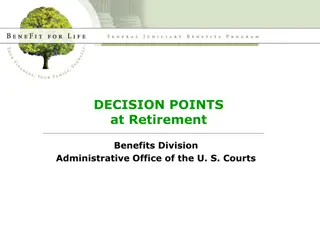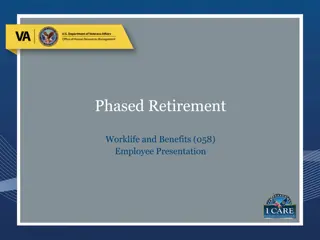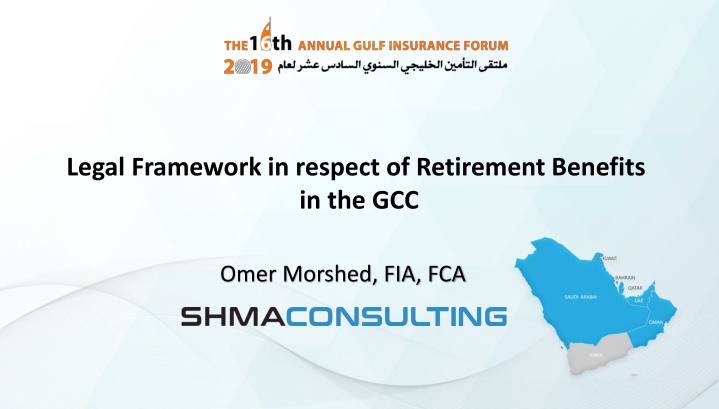
Retirement Benefits Framework and Legal Framework in GCC Countries
Explore the legal framework and retirement benefits system in Gulf Cooperation Council (GCC) countries, including state pension schemes, end-of-service benefits, and voluntary pension arrangements. Learn about the unique challenges posed by a high expatriate population and how the GCC countries address old-age support through distinct systems for nationals and expatriates.
Download Presentation

Please find below an Image/Link to download the presentation.
The content on the website is provided AS IS for your information and personal use only. It may not be sold, licensed, or shared on other websites without obtaining consent from the author. If you encounter any issues during the download, it is possible that the publisher has removed the file from their server.
You are allowed to download the files provided on this website for personal or commercial use, subject to the condition that they are used lawfully. All files are the property of their respective owners.
The content on the website is provided AS IS for your information and personal use only. It may not be sold, licensed, or shared on other websites without obtaining consent from the author.
E N D
Presentation Transcript
Legal Framework in respect of Retirement Benefits in the GCC Omer Morshed, FIA, FCA
Presentation Flow Retirement Benefit Framework State Pension Schemes in the GCC End of Service Benefits in the GCC Voluntary Pensions Arrangements
Traditional Old Age Income Framework Pillar 0 Extremely Poor Sometimes Added In
Special Circumstances in GCC Countries GCC countries differ from other countries in terms of a large proportion of their populations being expatriates. Proportion of expatriates by country: KSA 38% UAE 87% Kuwait 70% Oman 44% Qatar 87% Bahrain 55% This impacts the way these countries address the old age problem as the vast majority of expatriates return to their home countries post-retirement.
How The 3 Pillars are Addressed in GCC Countries Pillar 1 State Pension Pillar 2 Pillar 3 Voluntary Pensions Occupational Schemes Private Pensions State Schemes Nationals Covered by State Schemes Limited to Own Nationals Usually non-regulated Varying Degrees of Generosity Covered by Labour Laws very largely lump sum Gratuity (End of Service Benefits) which are defined benefit Regulations not required due to lack of any taxation on individuals Usually contributions by employers and members but guaranteed by state EOSB Schemes
Two Distinct Systems Two Distinct Systems Nationals Expatriates Covered by Social Security System - Run by state institutions set up for the purpose - Contributions by employer/member but scheme effectively guaranteed by government - Sometimes multiple institutions in a country dealing with different segments of the population - Benefits tend to be very generous compared to schemes in other countries (including developed ones) - Basic benefit includes a pension payable over time Not Covered by Social Security System - Employers are required to provide minimum benefits Cost borne by employers Basic benefit tends to be a lump sum based on length of service and final salary - -
State Pension Schemes in GCC The current pension schemes in the GCC region are Defined Benefits Plans, with high benefit levels compared to other countries.
Kingdom of Saudi Arabia Law: Social Insurance Law issued in 1969/ New Law in 2000 Retirement Age: 60 years men/ 55 women (younger for military) Entitlement criteria: 60 men / 55 women with Paid/Credited 120 months contributions Any age with 300 months of contribution if no longer covered Old Age Pension: Age/Contribution Term: Benefit: Insured Person: 9% of gross, Employer: 9% of gross, Govt: operating deficit 2.5% of average earnings for each year of contribution (max 100%) Disability Pension: Yes Survivor Pension: Eligible survivors include the widow(er); a dependent son younger than age 21 (age 26 if a full-time student); a dependent, unmarried daughter; and siblings, parents, grandparents, and grandchildren in certain circumstances.
United Arab Emirates Law: Social Insurance Law issued in 1999 and 2000 in Abu Dhabi Retirement Age: age 60 years (men) and 55 (women) Entitlement criteria: Abu Dhabi retirement age with 15 years service and 20 years service for lower ages retirement age or 25 years of service Old Age Pension: Contribution Term: Contribution Term Abu Dhabi: Insured Person: 5% of salary, Employer: 15% of salary, Govt: 6% Benefit: 60% of pension + 2% every additional year in excess of 15 years (max 100%) Benefit Abu Dhabi: 48% of pension + 3.2% every additional year in excess of 15 years (max 80%) Insured Person: 5% of salary, Employer: 15% of salary, Govt: 2.5% Disability Pension: Yes Survivor Pension: Eligible survivors include the widow(er); a dependent son younger than age 21 (age 28 if a full-time student); a dependent, unmarried daughter; siblings and parents.
Oman Law: Social Insurance Law issued in 1991 Cover: Civil Service Employees Pension Fund (government employees) Public Authority for Social Insurance (Private-sector or working in GCC) Foreign workers, household workers, self employed persons are excluded. Retirement Age: 60 years men / 55 years women Old Age Pension: Contribution Percentage: Age/Contribution Term: Benefit: Insured Person: 7% of salary, Employer: 10.5%, Government: 5.5% of salary Men: Age 60 and 180 months paid contributions; Women: Age 55, 120 months Early pension: Age 45 - 59 years; contributions: men (240 months), women(180) 3% of insured s average wage in the last 5 years of employment for each year of contribution (max 80%) Disability Pension: Yes Survivor Pension: Eligible survivors include the widow(er); a dependent son younger than age 22 (age 26 if a full-time student); an unmarried daughter; and siblings and parents.
Qatar Law: Social Insurance Law issued in 2002 Entitlement: Public, selected private or working in one of the GCC countries, Self-employed persons, household and foreign workers are excluded. Retirement Age: 60 years men / 55 years women Old Age Pension: Contribution Percentage: Age/Contribution Term: Benefit: Early Pension: Insured Person: 5% of gross, Employer: 10% of basic, Government: any deficit Men: Age 60 or Age 40 with 15 years of contribution Early pension: Age 45 - 59 years; contributions: men (240 months), women(180) 5% of wage for each year of contribution (max 100%) The above pension will reduce by 2% for each year before retirement age Disability Pension: Yes Survivor Pension: Eligible survivors include the widow(er); a dependent son younger than age 21 (age 26 if a full-time student); an unmarried daughter; and siblings and parents.
Kuwait Law: Social Insurance Law issued in 1976 and supplementary system in 1992 Entitlement: Retirement Age: Basic system: Public, Private and oil sector, self employed and military personnel. Supplementary system: monthly earning greater than 1,250 dinars or those with sources of earnings not covered by the basic system. 55 years men and 50 years women Old Age Pension: Basic system Contribution Percentage: Age/Contribution Term: Benefit: Insured Person: 5% of earnings, Employer: 10%, Government: 10% of earnings Age 50 with atleast 15 years of contributions for both men and Women 65% of insured last monthly earnings plus 2% for each year of contributions exceeding 15 years, (max 95%) Disability Pension: yes Survivor Pension: Eligible survivors include the widow; a dependent son younger than age 26 (age 28 if a full-time student); an unmarried daughter; and siblings, parents and son s children.
Bahrain Law: Social Insurance Law issued in 1976 Entitlement: Private-sector or working in one of the GCC countries, voluntary for Bahraini citizens working abroad. Foreign workers, household workers are excluded. Retirement Age: 60 years men / 55 years women with 10 years of contributions Old Age Pension: Contribution Percentage: Age/Contribution Term: Benefit: Early retirement Pension: Insured Person: 6% of earning, Employer: 9% of earning, Government: Nil Men: Age 60 and 180 months paid contributions; Women: Age 55, 120 months Early pension: Age 45 - 59 years; contributions: men (240 months), women(180) 2% of insured s average wage in the last 2 years of employment for each year of contribution (max 80% plus an additional 10%) at any age with 20 years of contributions (men) and 15 years (women) max 20% reduction if retirement age is less than 45 years Disability Pension: Survivor Pension: Yes Eligible survivors include the widow(er); a dependent son younger than age 22 (age 26 if a full-time student); an unmarried daughter; and siblings and parents.
Generous Benefit Structures Generous Benefit Structures Low Retirement Ages 50 to 60 years for males compared to 65+ in Europe Very high rate of accrual of benefits 2% to 2.5% compared to 0.89% in UK and 1% in Germany Pensions capped at a very high level 100% in some cases Pensions payable from younger ages without any actuarial reduction Generous survivorship pensions Children included to fairly high ages unmarried daughters; sons to 21 or 26 if still going through education. Even grandchildren if their father is not alive.
Inadequate Contributions and Funding Inadequate Contributions and Funding Contributions from employers and members not adequate to meet liabilities Funding of Past Service Cost Inadequate Working for the time being due to the ratio of active members to beneficiaries being very high Source: World Development Indicators, World Bank - (2014)
Young Populations Young Populations Very low proportion of retired persons Chart shows proportion of population over age 65 Source: World Development Indicators, World Bank - (2014)
But Ageing Fast But Ageing Fast Life Expectancy & Fertility Rate, 1980-2014 Source: World Development Indicators, World Bank
Recommendations Recommendations Rationalize Scheme Design Reduce benefit accrual factors Raise Retirement Ages (to at least 60 or actuarially reduce pensions) Increase contributions Improve collection of statistics and monitoring Possible grants from state to funds to increase funding ratio of schemes
End of Service Scheme Benefit Rules in GCC The current EOS schemes in the GCC region are Defined Benefits Plans, which means that the benefit is calculated according to the formula.
Kingdom of Saudi Arabia Retirement Age 65 years EOSB Payable Proportion month s salary for each year of service up to five years and then one month salary for each year of service thereafter. Exit Scenarios Resignation In case of the employee resigning from a contract of unspecified length, the benefits will be reduced by two-third in case of service being more than 2 years and less than 5 years, by one-third in case of service being more than 5 years and less than 10 years and the full terminal benefit is paid in case of service being more than 10 years. Termination In case of the employee being terminated from the contract, 100% of the benefits will be payable to the employee, except when for misconduct, disobedience or violation of any existing rules and regulations. End of Contract 100% of the benefits will be paid upon leaving the service on completion of contract term and with proper notice period
United Arab Emirates Retirement Age 60 years EOSB Payable Proportion 21 day s basic for each year of service up to five years and then one month basic for each year of service thereafter subject to a maximum of 24 months gross salary. The actual payout is based on the exit scenario detailed below. Exit Scenarios Resignation In case of the employee resigning from a contract of unspecified length, the benefits will be reduced by two-third in case of service being more than 1 year and less than 3 years, by one-third in case of service being more than 3 years and less than 5 years and the full terminal benefit is paid in case of service being more than 5 years. No gratuity is paid if the employee resigns in the first year of service. Termination In case of the employee being terminated from the contract, 100% of the entitlement will be paid to the employees, except when for misconduct, disobedience or violation of any existing rules and regulations.
Bahrain Retirement Age 60 years (Extendable) EOSB Payable Proportion Half month s wage for each of the first three years of employment and one month s wage for each of the following years in service. A worker shall be entitled to receive his leaving indemnity for fractions of the year in proportion to the period spent in the employer s service. Exit Scenarios Retirement upon the attainment of the normal retirement age Death in service of the employer Resignation from service Termination of his/her service by the Employer, other than for misconduct, negligence or incompetence
Qatar Retirement Age 60 years (Extendable) EOSB Payable Proportion Leaving indemnity calculated at the rate of 21 Days last drawn basic salary for each year of Service. Exit Scenarios Retirement upon the attainment of the normal retirement age Death in service of the employer Resignation from service Termination of his/her service by the Employer, other than for misconduct, negligence or incompetence
Kuwait Retirement Age 60 years EOSB Payable Proportion The worker shall be entitles to a 15 days remuneration for each of the first 5 years of service and one month remuneration for every year thereafter (Subject to maximum benefit of 18 months salaries). For Contracts of unspecified length, the benefit will be one third in case of service being more than 2 years and less than 5 years, two third in case of service being more than 5 years and less than 10 years and the full terminal benefit is paid in case of service being more than 10 years. Exit Scenarios Retirement upon the attainment of the normal retirement age Death in service of the employer Resignation from service Termination of his/her service by the Employer, other than for misconduct, negligence or incompetence
Oman Retirement Age 60 years (Extendable) EOSB Payable Proportion month s salary for each year of service up to five years and then one month salary for each year of service thereafter. Salary for EOSB calculation is the last drawn basic salary. Exit Scenarios Retirement upon the attainment of the normal retirement age Death in service of the employer Resignation from service Termination of his/her service by the Employer, other than for misconduct, negligence or incompetence
Summary of Standard Structure Summary of Standard Structure General target benefit 1 month salary for each year of service Variations Recently DIFC has introduced a regulations for shifting the EOSB from DB to DC benefits and regularly funding the scheme for service after the introduction of the scheme from January 2020 An Abu Dhabi public sector entity a few years ago merged EOSB with monthly emoluments thereby doing away with EOSB Accounting Strictly employer liability and period costs should be measured and disclosed in line with International Accounting Standard 19 However this is not uniformly followed - strictly imposed by most audit firms in KSA but not in other countries KSA EOSB liabilities increased by 20% when IAS 19 adopted for first time Almost all schemes are unfunded liability carried in employer entity balance sheets
Challenges with Current Structure Challenges with Current Structure These are End of Service Benefits and not Retirement Benefits Benefit paid out (and usually spent) on change of jobs, return to home country, etc Hence often very small amounts received on actual retirement This is, however, an issue with all lump sum employer controlled schemes Defined benefit schemes Therefore cost of salary increases need to be borne by employer Lack of Funding There are no separate assets to pay to the outgoing employees and employer has to use their working capital to pay the EOSB amounts Benefits at Risk if employer entity becomes insolvent No back up fund to pay even partial benefits in such an eventuality
Recommendations Recommendations Possibly switch to Defined Contribution Schemes with mandatory funding Life insurance and asset management companies can be licensed to offer US 401K type schemes with controlled charge structure and regulated investment policies Can offer continuity on persons switching jobs within a country or even within the GCC While the existing EOSB structure continues need to ensure adherence to IFRS framework (to IAS 19)
Voluntary Private Pensions Voluntary Private Pensions There is no formal system like the US 401K scheme or voluntary pensions in other countries No need for regulations as individual income is not taxed in the GCC A number of life insurance companies market long term life insurance savings products as retirement plans sometimes with an annuity option at retirement. Tend to have very high commissions and very low values (although IA has recently issued regulations to limit these the commissions will still be very high) Challenges remain for true pension products and annuities due to the transient nature of the majority of the population.

